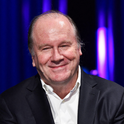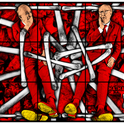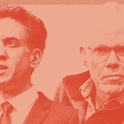Don DeLillo is more like a poet than a novelist. I don’t mean to say that his work is “poetic” in the vulgar sense of being melancholy or having florid descriptions of landscape and weather. Rather, that it’s interested in language before it’s interested in reality; in sound before sense; that his distinctive attention to the cadence of sentences is what makes DeLillo most DeLilloish; and that he’s pretty uninterested, or only slantwise, in the usual novelist stuff like characterisation, story and plot.
DeLillo has been hailed throughout his career as a prophet—as a writer who gets to the heart of the way we live now or the postmodern condition, whatever that is. Indeed he is. But even the most naturalistic of DeLillo’s work doesn’t portray anything much like real life. His novels don’t tell it like it is; they create something like—again, a term from poetics—an objective correlative for the feel of how it is.
The Silence opens with one of the best passages DeLillo has written for years. Absolutely nothing happens in it. A man and his wife, Jim and Tessa, are sitting on a transatlantic flight, bored. Tessa is writing in a “little blue notebook.” Jim—“he wanted to sleep but kept on looking”—is watching the information screens underneath the overhead luggage bins.
“Look,” he said, and the woman nodded faintly but kept on writing in a little blue notebook.
He began to recite the words and numbers aloud because it made no sense, it had no effect, if he simply noted the changing details only to lose each one instantly in the twin drones of mind and aircraft.
“Okay. Altitude thirty-three thousand and two feet. Nice and precise,” he said. “Température extérieure minus fifty-eight C.”
He paused, waiting for her to say Celsius, but she looked at the notebook on the tray table in front of her and then thought a while before continuing to write.
“Okay. Time in New York twelve fifty-five. Doesn’t say am or pm. Not that we have to be told.”
Sleep was the point. He needed to sleep. But the words and numbers kept coming.
“Arrival time sixteen thirty-two. Speed four seventy-one mph. Time to destination three thirty-four.”
“I’m thinking back to the main course,” she said. “I’m also thinking about the champagne with cranberry juice.”
“But you didn’t order it.”
“Seemed pretentious. But I’m looking forward to the scones later in the flight.”
She was talking and writing simultaneously.
“I like to pronounce the word properly,” she said. “An abbreviated letter o. As in scot or trot. Or is it scone as in moan?”
He was watching her write. Was she writing what she was saying, what they were both saying?
She said, “Celsius. Cap C. It was someone’s name. Can’t recall his first name.”
“Okay. What about vitesse. What does vitesse mean?”
“I’m thinking about Celsius and his work on the centigrade measurement.”
“Then there’s Fahrenheit.”
“Him too.”
“What does vitesse mean?”
“What?”
“Vitesse.”
This seems to me—as well as being quietly very funny—a representative passage. Here’s the listlessness, the anxiety, the sense of a process being automated into meaninglessness, the recursiveness (the writing, the talking, the idea that the conversation might be being written down in real time)—and the abstraction. These two people are hurtling through the air in a metal tube at nearly 500 miles an hour, and the experience is so thoroughly mediated as to become an idle string of numbers on a screen.
DeLillo’s dialogue captures the ellipses and non sequiturs of ordinary conversation—characters picking up on what was said several lines ago; obviously following their own trains of thought; offering sentence-fragments and irrelevances—but does so in a way that doesn’t quite resemble the real thing. It’s somehow both sparer than real-life chat, and fuller: amped up. The critic Michiko Kakutani has talked about DeLillo’s “Day-Glo powers.”
All that abstraction and mediation is headed for a fall in The Silence. At the very end of that first section something goes wrong. The plane begins to bounce from side to side. Red lights come on. “The screen went blank. Pilot speaking French, no English follow-up.” And we leave the pair just as the man, Jim, is imagining every passenger looking “straight ahead into the six o’clock news, at home, on channel 4, waiting for word of their crashed airliner.” Even their fear is meta. “Are we afraid?” Tessa asks.
Jump-cut. We’re in an apartment in New York. Jim and Tessa are awaited at a dinner party with old friends. Diane—a former professor of physics—and her husband Max are the hosts. They’re going to watch the Super Bowl. We learn that the year is 2022. Max is installed in his chair in front of the “superscreen TV.” Max has a bet on, and—attention fixed on the screen—says over his shoulder: “The money is always there, the point spread, the bet itself. But consciously I recognise a split. Whatever happens on the field I have the point spread secured in mind but not the bet itself.” “Big dollars,” Diane tells their other guest Martin, one of her former students, “But the actual amount is a number he keeps to himself. It is sacred territory.”
Here, as in that first passage on the airliner, is a sense of the hum of numbers behind everything, like the cosmic background radiation to DeLillo’s fiction: statistics, probabilities, stock markets, the mathematics of particle physics arranging the universe, the flow of information. Then the screen goes blank before the Super Bowl begins. The titular silence has fallen. Phones don’t work. New York is blacked out by (we assume) the same catastrophe that did for the airliner. A sort of abstract panic takes hold of the party guests. Tessa and Jim show up slightly later, a little bashed about, having survived the plane crash.
The assumption that the protagonists make is that this is a yet-to-be-understood act of war. The novel’s epigraph is Einstein’s remark that: “I do not know with what weapons World War III will be fought, but World War IV will be fought with sticks and stones.” Martin—most of whose conversation revolves around his “compulsive study” of Einstein’s 1912 Manuscript on the Special Theory of Relativity—refers to the remark later in the text. But DeLillo isn’t concerned with what happens in the war so much as what the effect of this sudden disconnection is on five people in a room. It’s the Samuel Beckett version of Threads.
“Nobody wants to call it World War III but this is what it is,” says Martin. And it’s a feature of this war that it is an absence rather than a presence. The narrator asks: “Do people experience memories of earlier conflicts, the spread of terrorism, the shaky video of someone approaching an embassy, a bomb vest strapped to his chest? Pray and die. War that we can see and feel. Is there a shred of nostalgia in these recollections?”
I remember reading somewhere an interview in which DeLillo was asked about the name of his protagonist in White Noise. He said “Jack Gladney” had been chosen for reasons of sound—something about the assonance of “Ja-” and “Gla-.” Sound effects are central to the way DeLillo’s writing works. Perhaps his signature sentence is the three-part list, with no main verb or the main verb in suspension: a technique more like collage than continuous prose.
“Commercials, station breaks, pregame babble.” “Half-sentences, bare words, repetitions.” “Wave structure, metric tensor, covariant qualities.” “Dark energy, phantom waves, hack and counterhack.” “Cyberattacks, digital intrusions, biological aggressions. Anthrax, smallpox, pathogens. The dead and disabled. Starvation, plague, what else? Power grids collapsing. Our personal perception sinking into quantum dominance.”
It all works more like poetry. It creates a vibe. The characters in The Silence—and to a large extent the somewhat slippery narrator—babble expressions with the sheen of ultra-modernity. But nothing connects firmly to anything. “Drones above us now. Flinging warnings at each other. Their weapon being a form of the language isolate. A language known only to drones.”
[su_pullquote]“Jim and Tessa have emergency sex in a toilet cubicle in the aftermath of the plane crash”[/su_pullquote]
When Martin starts talking in broken sentences about “cryptocurrencies” there’s no obvious sense in which it has anything to do with the catastrophe. It’s as if language itself is coming unlatched from the reality it was supposed to tame. But still, there’s a comfort to making a noise, any noise. Speech, even as meaning breaks down, as a hedge against the silence: “There’s nothing else to say except what comes into our heads, which none of us will remember anyway.” Max delivers the commentary on an imaginary football game. Martin starts ventriloquising Einstein. And Diane notices: “Somewhere within all those syllables, something secret, covert, intimate.”
Human intimacy, basic bodily function, is what endures under it all. Jim and Tessa have emergency sex in a toilet cubicle in the aftermath of the plane crash (“Tessa whispered a list of nationalities as they completed the act and crudely wiped each other with tissues from the dispenser adjacent to the mirror”). Diane and Martin enjoy an intense but unconsummated moment of sexual tension. There are gloves to be worn, as the temperature in the apartment goes down. There is food to be eaten, and bourbon to be drunk.
Tessa wonders: “Is it natural at a time like this to be thinking and talking in philosophical terms as some of us have been doing? Or should we be practical? Food, shelter, friends, flush the toilet if we can?” Answer came there none. The final image is of Max:
Max is not listening. He understands nothing. He sits in front of the TV set with his hands folded behind his neck, elbows jutting.
Then he stares into the blank screen.
The Silence by Don DeLillo (Picador, £14.99)













